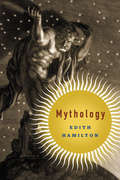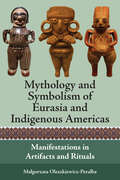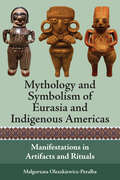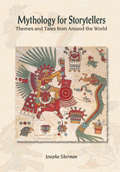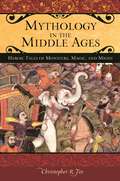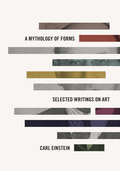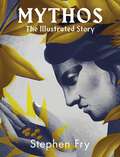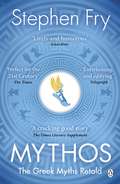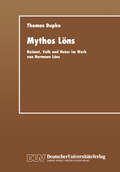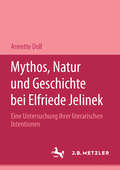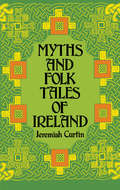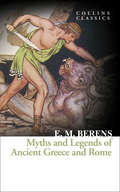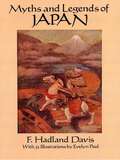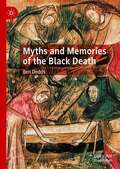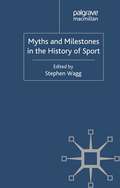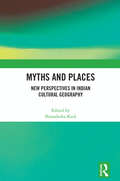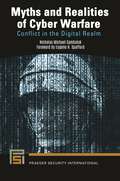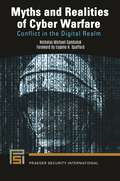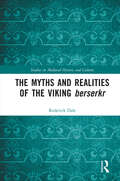- Table View
- List View
Mythology: Timeless Tales Of Gods And Heroes (Mentor Ser.)
by Edith Hamilton Aphrodite Trust Apollo TrustThe world-renowned classic that has enthralled and delighted millions of readers with its timeless tales of gods and heroes.Edith Hamilton's mythology succeeds like no other book in bringing to life for the modern reader the Greek, Roman and Norse myths that are the keystone of Western culture-the stories of gods and heroes that have inspired human creativity from antiquity to the present.We follow the drama of the Trojan War and the wanderings of Odysseus. We hear the tales of Jason and the Golden Fleece, Cupid and Psyche, and mighty King Midas. We discover the origins of the names of the constellations. And we recognize reference points for countless works for art, literature and culture inquiry-from Freud's Oedipus complex to Wagner's Ring Cycle of operas to Eugene O'Neill's Mourning Becomes ElectraBoth a reference text for scholars of all ages and a book to simply enjoy, Mythology is a classic not to be missed.
Mythology and Symbolism of Eurasia and Indigenous Americas: Manifestations in Artifacts and Rituals
by Małgorzata Oleszkiewicz-PeralbaA system of myths, symbols, and rituals, dating back to the Paleolithic and Neolithic, survives in present-day imagery. In exploring this system, special attention is drawn to the linkage between ancient and contemporary civilizations of Eurasia and Mesoamerica, as seen in their cosmology, and expressed in common mythological and iconographic themes. The author examines contemporary Middle American and eastern European textiles, especially women’s garments, that contain an elaborated sacred code of symbols, and include remnants of the four horizontal directions, and the three vertical worlds that portray the structure of the universe. The cosmology contained in patterns around the world denotes striking parallels that attest to internal connections between different cultures, beyond time and place.
Mythology and Symbolism of Eurasia and Indigenous Americas: Manifestations in Artifacts and Rituals
by Małgorzata Oleszkiewicz-PeralbaA system of myths, symbols, and rituals, dating back to the Paleolithic and Neolithic, survives in present-day imagery. In exploring this system, special attention is drawn to the linkage between ancient and contemporary civilizations of Eurasia and Mesoamerica, as seen in their cosmology, and expressed in common mythological and iconographic themes. The author examines contemporary Middle American and eastern European textiles, especially women’s garments, that contain an elaborated sacred code of symbols, and include remnants of the four horizontal directions, and the three vertical worlds that portray the structure of the universe. The cosmology contained in patterns around the world denotes striking parallels that attest to internal connections between different cultures, beyond time and place.
Mythology for Storytellers: Themes and Tales from Around the World
by Howard J ShermanIllustrated in full color throughout, this delightful collection puts the riches of world mythology at the fingertips of students and storytellers alike. It is a treaury of favorite and little-known tales from Africa, Asia, Europe, the Americas, Australia, and Oceania, gracefully retold and accompanied by fascinating, detailed information on their historic and cultural backgrounds. The introduction provides an informative overview of mythology, its purpose in world cultures, and myth in contemporary society and popular culture. Mythic themes are defined and the often-misunderstood difference between myth and legend explained. Following this, the main sections of the book are arranged thematically, covering The Creation, Death and Rebirth, Myths of Origins, Myths of the Gods, and Myths of Heroes. Each section begins by comparing its theme cross-culturally, explaining similarities and differences in the mthic narratives. Myths from diverse cultures are then presented, introduced, and retold in a highly readable fashion. A bibliography follows each retelling so readers can find more information on the culture, myth, and deities. Character, geographical, and general indexes round out this volume, and a master bibliography facilitates research. For students, storytellers, or anyone interested in the wealth of world mythology, Mythology: Stories and Themes from Around the World provides answers to common research questions, sources for myths, and stories that will delight, inform, and captivate.
Mythology for Storytellers: Themes and Tales from Around the World
by Howard J ShermanIllustrated in full color throughout, this delightful collection puts the riches of world mythology at the fingertips of students and storytellers alike. It is a treaury of favorite and little-known tales from Africa, Asia, Europe, the Americas, Australia, and Oceania, gracefully retold and accompanied by fascinating, detailed information on their historic and cultural backgrounds. The introduction provides an informative overview of mythology, its purpose in world cultures, and myth in contemporary society and popular culture. Mythic themes are defined and the often-misunderstood difference between myth and legend explained. Following this, the main sections of the book are arranged thematically, covering The Creation, Death and Rebirth, Myths of Origins, Myths of the Gods, and Myths of Heroes. Each section begins by comparing its theme cross-culturally, explaining similarities and differences in the mthic narratives. Myths from diverse cultures are then presented, introduced, and retold in a highly readable fashion. A bibliography follows each retelling so readers can find more information on the culture, myth, and deities. Character, geographical, and general indexes round out this volume, and a master bibliography facilitates research. For students, storytellers, or anyone interested in the wealth of world mythology, Mythology: Stories and Themes from Around the World provides answers to common research questions, sources for myths, and stories that will delight, inform, and captivate.
Mythology in the Middle Ages: Heroic Tales of Monsters, Magic, and Might (Praeger Series on the Middle Ages)
by Christopher R. FeePlacing heroes from a wide range of medieval traditions shoulder to shoulder, this title provides the opportunity to examine what is common across medieval mythic, legendary, and folkloric traditions, as well as what seems unique.Myths of gods, legends of battles, and folktales of magic abound in the heroic narratives of the Middle Ages. Mythology in the Middle Ages: Heroic Tales of Monsters, Magic, and Might describes how Medieval heroes were developed from a variety of source materials: Early pagan gods become euhemerized through a Christian lens, and an older epic heroic sensibility was exchanged for a Christian typological and figural representation of saints. Most startlingly, the faces of Christian martyrs were refracted through a heroic lens in the battles between Christian standard-bearers and their opponents, who were at times explicitly described in demonic terms.The book treats readers to a fantastic adventure as author Christopher R. Fee guides them on the trail of some of the greatest heroes of medieval literature. Discussing the meanings of medieval mythology, legend, and folklore through a wide variety of fantastic episodes, themes, and motifs, the journey takes readers across centuries and through the mythic, legendary, and folkloric imaginations of different peoples. Coverage ranges from the Atlantic and Baltic coasts of Europe, south into the Holy Roman Empire, west through the Iberian peninsula, and into North Africa. From there, it is east to Byzantium, Russia, and even the far reaches of Persia.
A Mythology of Forms: Selected Writings on Art
by Carl EinsteinThe German art historian and critic Carl Einstein (1885-1940) was at the forefront of the modernist movement that defined the twentieth century. One of the most prolific and brilliant early commentators on cubism, he was also among the first authors to assess African sculpture as art. Yet his writings remain relatively little known in the Anglophone world. With A Mythology of Forms, the first representative collection of Einstein’s art theory and criticism to appear in English translation, Charles W. Haxthausen fills this gap. Spanning three decades, it assembles the most important of Einstein’s writings on the art that was central to his critical project—on cubism, surrealism, Pablo Picasso, Georges Braque, and Paul Klee, and includes the full texts of his two pathbreaking books on African art, Negro Sculpture (1915) and African Sculpture (1921). With fourteen texts by Einstein, each presented with extensive commentary, A Mythology of Forms will bring a pivotal voice in the history of modern art into English.
A Mythology of Forms: Selected Writings on Art
by Carl EinsteinThe German art historian and critic Carl Einstein (1885-1940) was at the forefront of the modernist movement that defined the twentieth century. One of the most prolific and brilliant early commentators on cubism, he was also among the first authors to assess African sculpture as art. Yet his writings remain relatively little known in the Anglophone world. With A Mythology of Forms, the first representative collection of Einstein’s art theory and criticism to appear in English translation, Charles W. Haxthausen fills this gap. Spanning three decades, it assembles the most important of Einstein’s writings on the art that was central to his critical project—on cubism, surrealism, Pablo Picasso, Georges Braque, and Paul Klee, and includes the full texts of his two pathbreaking books on African art, Negro Sculpture (1915) and African Sculpture (1921). With fourteen texts by Einstein, each presented with extensive commentary, A Mythology of Forms will bring a pivotal voice in the history of modern art into English.
A Mythology of Forms: Selected Writings on Art
by Carl EinsteinThe German art historian and critic Carl Einstein (1885-1940) was at the forefront of the modernist movement that defined the twentieth century. One of the most prolific and brilliant early commentators on cubism, he was also among the first authors to assess African sculpture as art. Yet his writings remain relatively little known in the Anglophone world. With A Mythology of Forms, the first representative collection of Einstein’s art theory and criticism to appear in English translation, Charles W. Haxthausen fills this gap. Spanning three decades, it assembles the most important of Einstein’s writings on the art that was central to his critical project—on cubism, surrealism, Pablo Picasso, Georges Braque, and Paul Klee, and includes the full texts of his two pathbreaking books on African art, Negro Sculpture (1915) and African Sculpture (1921). With fourteen texts by Einstein, each presented with extensive commentary, A Mythology of Forms will bring a pivotal voice in the history of modern art into English.
A Mythology of Forms: Selected Writings on Art
by Carl EinsteinThe German art historian and critic Carl Einstein (1885-1940) was at the forefront of the modernist movement that defined the twentieth century. One of the most prolific and brilliant early commentators on cubism, he was also among the first authors to assess African sculpture as art. Yet his writings remain relatively little known in the Anglophone world. With A Mythology of Forms, the first representative collection of Einstein’s art theory and criticism to appear in English translation, Charles W. Haxthausen fills this gap. Spanning three decades, it assembles the most important of Einstein’s writings on the art that was central to his critical project—on cubism, surrealism, Pablo Picasso, Georges Braque, and Paul Klee, and includes the full texts of his two pathbreaking books on African art, Negro Sculpture (1915) and African Sculpture (1921). With fourteen texts by Einstein, each presented with extensive commentary, A Mythology of Forms will bring a pivotal voice in the history of modern art into English.
Mythos: The stunningly iIllustrated story
by Stephen FryStep into Stephen Fry’s richly colourful world of magic, mayhem, monsters and maniacal gods in MYTHOS: THE ILLUSTRATED STORYNo one loves and quarrels, desires and deceives as boldly or brilliantly as Greek gods and goddesses.In Stephen Fry's vivid retelling, we gaze in wonder as wise Athena is born from the cracking open of the great head of Zeus and follow doomed Persephone into the dark and lonely realm of the Underworld. We shiver in fear when Pandora opens her jar of evil torments and watch with joy as the legendary love affair between Eros and Psyche unfolds.Mythos: The Illustrated Story captures these extraordinary myths for our modern age in striking colour - in all their dazzling and deeply human relevance.
Mythos: The Greek Myths Retold (Stephen Fry’s Greek Myths #1)
by Stephen FrySTEP INTO ANOTHER WORLD - OF MAGIC, MAYHEM, MONSTERS AND MANIACAL GODS - IN STEPHEN FRY'S MOMENTOUS SUNDAY TIMES BESTSELLER, MYTHOS'A romp through the lives of ancient Greek gods. Fry is at his story-telling best . . . the gods will be pleased' TimesDiscover Stephen Fry's magnificent retelling of the greatest myths and legends ever told . . .___________No one loves and quarrels, desires and deceives as boldly or brilliantly as Greek gods and goddesses.In Stephen Fry's vivid retelling, we gaze in wonder as wise Athena is born from the cracking open of the great head of Zeus and follow doomed Persephone into the dark and lonely realm of the Underworld. We shiver in fear when Pandora opens her jar of evil torments and watch with joy as the legendary love affair between Eros and Psyche unfolds.Mythos captures these extraordinary myths for our modern age - in all their dazzling and deeply human relevance.If you're enthralled by the magic of Greek mythology you'll love Fry's latest book TROY, an exceptional retelling of our greatest story . . .___________NOW THE INSPIRATION FOR THE MYTHOS SUITE, STEPHEN FRY AND DEBBIE WISEMAN'S MUSICAL PRODUCTION OF FRY'S THRILLING RETELLINGS'A head-spinning marathon of legends' Guardian'An Olympian feat. The gods seem to be smiling on Fry - his myths are definitely a hit' Evening Standard'An odyssey through Greek mythology. Brilliant . . . all hail Stephen Fry' Daily Mail'A rollicking good read' IndependentSHORTLISTED FOR A NATIONAL BOOK AWARD
Mythos, Natur und Geschichte bei Elfriede Jelinek: Eine Untersuchung ihrer literarischen Intentionen. M&P Schriftenreihe
by Annette DollMyths and Folk Tales of Ireland (Celtic, Irish)
by Jeremiah CurtinTwenty folk tales representing hundreds of years of the collective Irish imagination transport readers to a world where everything is alive and anything can happen! Vivid descriptions of battles with giants, dead men who come back to life, humans imprisoned in animals' bodies, heroes with incredible strength, and more.
Myths and Legends of Ancient Greece and Rome: Illustrated (Collins Classics)
by E. M. BerensHarperCollins is proud to present its incredible range of best-loved, essential classics.
Myths and Legends of Japan
by F. Hadland DavisThe most popular myths and legends of Japanese culture are charmingly retold in English in this handsomely illustrated book. Here are myths of gods, heroes and warriors; legends of Buddha, and of the goddess Benten and the god Daikoku; tales of the sea and of Mount Fuji; accounts of superstitions and supernatural beings; observations on the spiritual properties of fans, flowers, dolls and butterflies and much more.The collection begins with the early myths of Japan, which the author describes as "quaint, beautiful, quasi-humorous." These are followed by legends celebrating early heroes and warriors, and the earliest examples of the Japanese romance, "The Bamboo-Cutter and the Moon-Maiden." Many of the legends that follow reflect a poetic love of beauty and of nature. But as the author points out, "there is plenty of crude realism in Japanese legend. We are repelled by the Thunder God's favorite repast, amazed by the magical power of foxes and cats; and the story of 'Hōïchi-the-Earless' and of the corpse-eating priest afford striking examples of the combination of the weird and the horrible."Thirty-two full-page illustrations offer compelling images of Buddha and the Dragon; A Kakemono Ghost; The Jelly-Fish and the Monkey; The Firefly Battle; Tokoyo and the Sea Serpent; Sengen, the Goddess of Mount Fuji; and other subjects of these timeless myths. In addition, the author has included several invaluable appendixes that offer a helpful note on Japanese poetry, a listing of gods and goddesses, a genealogy of The Age of the Gods, and an index of poetical quotations.
Myths and Memories of the Black Death
by Ben DoddsThis book explores modern representations of the Black Death, a medieval pandemic. The concept of cultural memory is used to examine the ways in which journalists, writers of fiction, scholars and others referred to, described and explained the Black Death from around 1800 onwards. The distant medieval past was often used to make sense of aspects of the present, from the cholera pandemics of the nineteenth-century to the climate crisis of the early twenty-first century. A series of overlapping myths related to the Black Death emerged based only in part on historical evidence. Cultural memory circulates in a variety of media from the scholarly article to the video game and online video clip, and the connections and differences between mediated representations of the Black Death are considered. The Black Death is one of the most well-known aspects of the medieval world, and this study of its associated memories and myths reveals the depth and complexity of interactions between the distant and recent past.
Myths and Milestones in the History of Sport
by Stephen WaggThe conventional history of sport, as conveyed by television and the sports press, has thrown up a great many apparent turning points, but knowledge of these apparently defining moments is often slight. This book offers readable, in-depth studies of a series of these watersheds in sport history and of the circumstances in which they came about.
Myths and Places: New Perspectives in Indian Cultural Geography
by Shonaleeka KaulThis volume explores the dialogic relationship between myths and places in the historically, geographically, and culturally diverse context of India. Given its ambiguous relationship with ‘facts’ and empirical reality, myth has suffered an uncertain status in the field of professional history, with the latter’s preference for scientifism over more creative orders of representation. Myths and Places rehabilitates myth, not as history’s primeval ‘Other’, nor as an instrument of socio-religious propagation, but as communitarian mechanisms by which societies made sense of themselves and their world. It argues that myths helped communities fashion their identities and their habitat/habitus, and were fashioned by these in turn. This book explores diverse forms of territorial becoming and belonging in a grassroots approach from across India, studying them in culturally sensitive ways to recover local life-worlds and their self-understanding. Further, challenging the stereotypical bracketing of the mythical with the sacred and the material with the historical, the multidisciplinary essays in the book examine myth in relation to not only religion but other historical phenomena such as ecology, ethnicity, urbanism, mercantilism, migration, politics, tourism, art, philosophy, performance, and the everyday. This book will be of interest to scholars and general readers of Indian history, regional studies, cultural geography, mythology, religious studies, and anthropology.
Myths and Places: New Perspectives in Indian Cultural Geography
This volume explores the dialogic relationship between myths and places in the historically, geographically, and culturally diverse context of India. Given its ambiguous relationship with ‘facts’ and empirical reality, myth has suffered an uncertain status in the field of professional history, with the latter’s preference for scientifism over more creative orders of representation. Myths and Places rehabilitates myth, not as history’s primeval ‘Other’, nor as an instrument of socio-religious propagation, but as communitarian mechanisms by which societies made sense of themselves and their world. It argues that myths helped communities fashion their identities and their habitat/habitus, and were fashioned by these in turn. This book explores diverse forms of territorial becoming and belonging in a grassroots approach from across India, studying them in culturally sensitive ways to recover local life-worlds and their self-understanding. Further, challenging the stereotypical bracketing of the mythical with the sacred and the material with the historical, the multidisciplinary essays in the book examine myth in relation to not only religion but other historical phenomena such as ecology, ethnicity, urbanism, mercantilism, migration, politics, tourism, art, philosophy, performance, and the everyday. This book will be of interest to scholars and general readers of Indian history, regional studies, cultural geography, mythology, religious studies, and anthropology.
Myths and Realities of Cyber Warfare: Conflict in the Digital Realm (Praeger Security International)
by Nicholas Michael SambalukThis illuminating book examines and refines the commonplace "wisdom" about cyber conflict—its effects, character, and implications for national and individual security in the 21st century."Cyber warfare" evokes different images to different people. This book deals with the technological aspects denoted by "cyber" and also with the information operations connected to social media's role in digital struggle.The author discusses numerous mythologies about cyber warfare, including its presumptively instantaneous speed, that it makes distance and location irrelevant, and that victims of cyber attacks deserve blame for not defending adequately against attacks. The author outlines why several widespread beliefs about cyber weapons need modification and suggests more nuanced and contextualized conclusions about how cyber domain hostility impacts conflict in the modern world.After distinguishing between the nature of warfare and the character of wars, chapters will probe the widespread assumptions about cyber weapons themselves. The second half of the book explores the role of social media and the consequences of the digital realm being a battlespace in 21st-century conflicts. The book also considers how trends in computing and cyber conflict impact security affairs as well as the practicality of people's relationships with institutions and trends, ranging from democracy to the Internet of Things.
Myths and Realities of Cyber Warfare: Conflict in the Digital Realm (Praeger Security International)
by Nicholas Michael SambalukThis illuminating book examines and refines the commonplace "wisdom" about cyber conflict—its effects, character, and implications for national and individual security in the 21st century."Cyber warfare" evokes different images to different people. This book deals with the technological aspects denoted by "cyber" and also with the information operations connected to social media's role in digital struggle.The author discusses numerous mythologies about cyber warfare, including its presumptively instantaneous speed, that it makes distance and location irrelevant, and that victims of cyber attacks deserve blame for not defending adequately against attacks. The author outlines why several widespread beliefs about cyber weapons need modification and suggests more nuanced and contextualized conclusions about how cyber domain hostility impacts conflict in the modern world.After distinguishing between the nature of warfare and the character of wars, chapters will probe the widespread assumptions about cyber weapons themselves. The second half of the book explores the role of social media and the consequences of the digital realm being a battlespace in 21st-century conflicts. The book also considers how trends in computing and cyber conflict impact security affairs as well as the practicality of people's relationships with institutions and trends, ranging from democracy to the Internet of Things.
The Myths and Realities of the Viking Berserkr (Studies in Medieval History and Culture)
by Roderick DaleThe viking berserkr is an iconic warrior normally associated with violent fits of temper and the notorious berserksgangr or berserker frenzy. This book challenges the orthodox view that these men went ‘berserk’ in the modern English sense of the word. It examines all the evidence for medieval perceptions of berserkir and builds a model of how the medieval audience would have viewed them. Then, it extrapolates a Viking Age model of berserkir from this model, and supports the analysis with anthropological and archaeological evidence, to create a new and more accurate paradigm of the Viking Age berserkr and his place in society. This shows that berserkir were the champions of lords and kings, members of the social elite, and that much of what is believed about them is based on 17th-century and later scholarship and mythologizing: the medieval audience would have had a very different understanding of the Old Norse berserkr from that which people have now. The book sets out a challenge to rethink and reframe our perceptions of the past in a way that is less influenced by our own modern ideas. The Myths and Realities of the Viking berserkr will appeal to researchers and students alike studying the Viking Age, Medieval History and Old Norse Literature.
The Myths and Realities of the Viking Berserkr (Studies in Medieval History and Culture)
by Roderick DaleThe viking berserkr is an iconic warrior normally associated with violent fits of temper and the notorious berserksgangr or berserker frenzy. This book challenges the orthodox view that these men went ‘berserk’ in the modern English sense of the word. It examines all the evidence for medieval perceptions of berserkir and builds a model of how the medieval audience would have viewed them. Then, it extrapolates a Viking Age model of berserkir from this model, and supports the analysis with anthropological and archaeological evidence, to create a new and more accurate paradigm of the Viking Age berserkr and his place in society. This shows that berserkir were the champions of lords and kings, members of the social elite, and that much of what is believed about them is based on 17th-century and later scholarship and mythologizing: the medieval audience would have had a very different understanding of the Old Norse berserkr from that which people have now. The book sets out a challenge to rethink and reframe our perceptions of the past in a way that is less influenced by our own modern ideas. The Myths and Realities of the Viking berserkr will appeal to researchers and students alike studying the Viking Age, Medieval History and Old Norse Literature.
